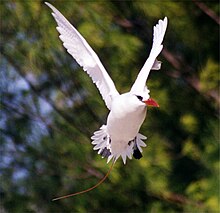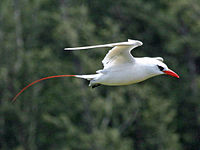Red-tailed tropicbird
| Red-tailed tropicbird | |
|---|---|

| |
| Red-tailed tropicbird | |
| Scientific classification | |
| Kingdom: | |
| Phylum: | |
| Class: | |
| Order: | |
| Family: | |
| Genus: | |
| Species: | P. rubricauda'
|
| Binomial name | |
| Phaethon rubricauda Boddaert, 1783
| |
The red-tailed tropicbird (Phaethon rubricauda) is a seabird that nests across the Indian and Pacific Oceans. It nests in colonies on oceanic islands. The species is also known by its Maori name, amokura.[2]
Description
The red-tailed tropicbird looks like a stout tern, and hence closely resembles the other two tropicbird species. It has generally white plumage, often with a pink tinge, a black crescent around the eye and a thin red tail feather. It has a bright red bill and black feet.
Behaviour and range
The red-tailed tropicbird nests on oceanic islands in large colonies from the Hawaiian Islands to Easter Island and across to Mauritius and the Reunion Island. In Madagascar they nest on the tiny island of Nosy Ve. In Australia, they nest on Queensland's coral islands (including Lady Elliot Island) and islands off Western Australia. They disperse widely after breeding, birds ringed in Hawaii have been recovered as far away as Japan and the Philippines. They range from the Red Sea to New Zealand and Chile.
When breeding, they mainly choose coral atolls with low shrubs, nesting underneath them (or occasionally in limestone cavities). They feed offshore away from land, singly rather than in flocks. They are plunge-divers that feed on fish, mostly flying fish, and squid.
Strong winds can blow them inland on occasions, which explains some sighting records away from the coast and their preferred habitats.
Gallery
-
Kilauea Lighthouse, Kauai, Hawaii
-
Nesting, Nosy Ve, Madagascar
-
Young bird on Nosy Ve, Madagascar
References
External links
- IUCN Red List least concern species
- Phaethontidae
- Birds of Christmas Island
- Birds of the Cook Islands
- Birds of Hawaii
- Birds of the Indian Ocean
- Birds of the Maluku Islands
- Birds of Mauritius
- Birds of the Pacific Ocean
- Birds of Palau
- Birds of Queensland
- Birds of Réunion
- Birds of Western Australia
- Animals described in 1783




